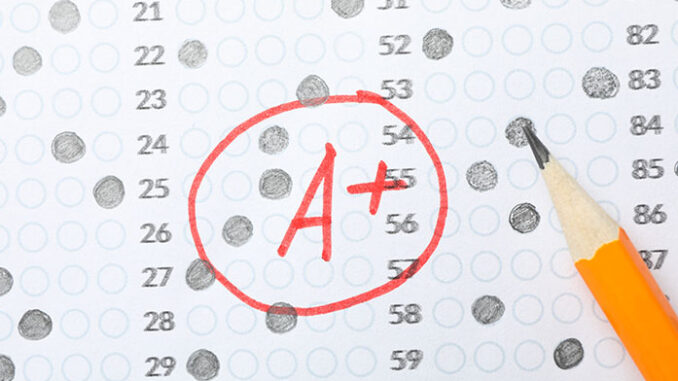
The Arizona State Board of Education (ASBE) determined that nearly 80 percent of schools are succeeding with “A” or “B” grades.
Altogether, about 37 percent of schools received an “A” grade. 40 percent received a “B” grade.
18 percent received a “C” grade. Two percent received a “D” grade. Less than a percent received an “F” grade (12 total schools). About three percent remain under review.
The grades break down between K-8, high schools, hybrid schools, and alternative schools.
For traditional K-8 schools: 34 percent (469) were “A” schools. 39 percent (530) were “B” schools. 21 percent (280) were “C” schools. Three percent (39) were “D” schools. About half a percent (eight) received an “F” grade. Two percent of schools (33 schools) remain under review.
The average Arizona student scored over a point lower than the average national composite score.
For traditional high schools: 51 percent (117) were “A” schools. 39 percent (91) were “B” schools. Six percent (13) were “C” schools. No school received a “D” grade. One school received an “F” grade. Four percent (nine) remain under review.
For traditional hybrid schools: 43 percent (60) were “A” schools. 30 percent (42) were “B” schools. 21 percent (29) were “C” schools. Three percent (four) were “D” schools. No schools received a failing grade. Three percent (four) remain under review.
For alternative schools: 27 percent (39) were “A” schools. 65 percent (92) were “B” schools. Four percent (six) were “C” schools. No schools received a “D” grade. Two percent (three) were “F” schools. About one percent of schools (two) remain under review.
Upon the publishing of these latest grades, parents questioned the perceived inconsistency between school grades and student outcomes.
The state’s average composite score for the ACT was less than 18 out of 36. The average English score was nearly 17, the average math and reading scores were both under 18, and the average science score was 18.
99 percent of graduates were tested. The average Arizona student scored over a point lower than the average national composite score.
School letter grades are useful only to taxpayer-funded government school PR departments. https://t.co/3oZ97948Tk
— Scottsdale Unites for Educational Integrity (@ScottsdaleUnite) November 13, 2025
ASBE has continued to update the school grading numbers as they receive more review requests. The latest update of more schools requesting review due to an appeal submission came in on Friday.
“A” aligns with “excellence”: distinguished performance on the statewide assessment, significant student growth, high four-year graduation rates, students on track to proficiency, overall performance is significantly higher than the state average.
“B” aligns with “highly performing”: high performance on statewide assessment and/or significant student growth and/or higher four-year graduation rates and/or moving students to proficiency at a higher rate than the state average.
“F” aligns with “failing”: systematic failures in proficiency, growth, and graduate rates are below 67 percent with performance at the bottom five percent of the state.
ASBE measures several performance indicators within accountability plans that vary based on K-8, high school, and high school alternative.
K-8 indicators encompass proficiency in English and math; growth in English and Math performance from year to year; English Language Learners proficiency on their English Learner Assessment and changes in performance levels; acceleration or readiness measured across math and English, decreases in chronic absenteeism, inclusion of special education students in general education, and improving student subgroup scores; and special education enrollment. Science proficiency and special education enrollment numbers are considered the lowest-weighted indicators.
Similarly, high school indicators encompass proficiency in English and math; growth in ACT Aspire English and Math performance from 9th grade to 11th grade; high school graduation rate; and college and career readiness. The lowest-weighted indicators are science performance; ACT Aspire performance equal to or above 90 percent; special education enrollment, and postsecondary and military enrollment.
High school alternative accountability plans also review English and math proficiency, high school graduation rates, college and career readiness, and ACT Aspire performance. The alternative plan also focuses on English Language Learners’ performance and subgroup graduation rates.

Be the first to comment